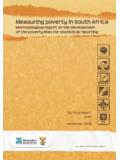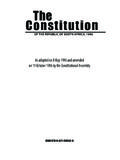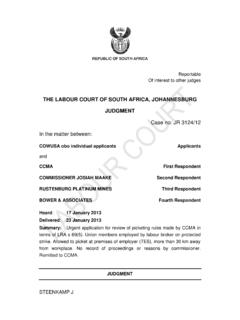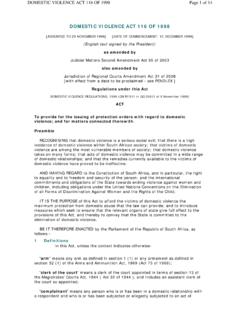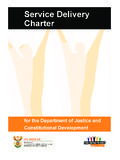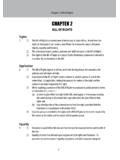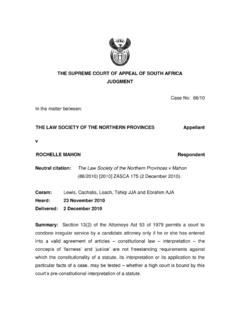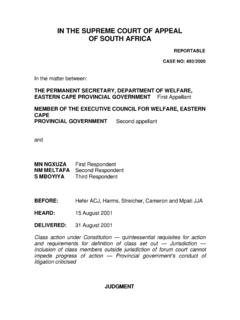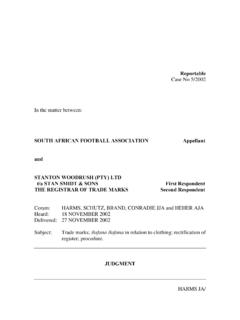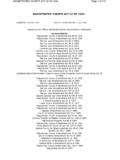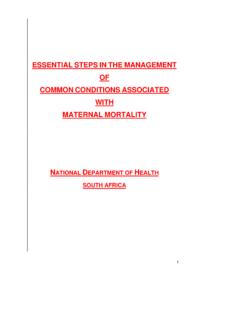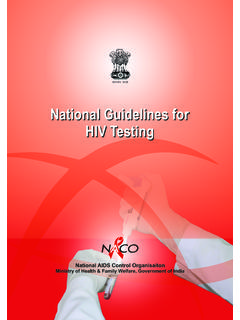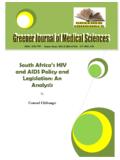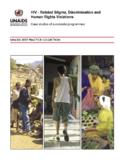Transcription of POLICY GUIDELINE FOR HIV COUNSELLING AND TESTING …
1 POLICY GUIDELINE FOR HIV. COUNSELLING AND TESTING . (HCT). National Department of Health PIC 22 October, 2009. FOREWORD. HIV and aids is one of the most important challenges facing South Africa today. Government has made the fight against this disease one of its top priorities. In order to guide the National response, the South African government recently updated previous commitments and developed the National Strategic Plan (NSP). for HIV & aids and STIs, 2007-2011. The NSP outlines four key priority areas for the country; viz. Prevention; Treatment, Care and Support; Research, Monitoring and Surveillance; and Human Rights and Access to Justice. Two primary goals inform all four priority areas: to reduce the incidence of new HIV infections in South Africa by half by 2011, and to ensure that at least 80% of those who are already HIV-positive have access to treatment. Knowledge of HIV status is critical to both these prevention and treatment goals. The implementation of the HIV COUNSELLING and TESTING (HCT) programme within a legal and human rights framework is a key intervention towards the realisation of the goals of the NSP.
2 HCT is an entry point to a comprehensive continuum of care. Once an individual has been tested for HIV, prevention can be reinforced and referral made to available treatment, care and support services. HCT has become increasingly available in South Africa in recent years. Despite increasing availability of HCT in many public health facilities, uptake of COUNSELLING and TESTING remains low. Government is engaged in wide scale social mobilisation in an effort to increase the uptake of this service by the all the people of South Africa. The aim of the HCT programme is to provide an integrated service at all levels of the public health service delivery system. It encourages and supports formal collaboration between the public, private and NGO sectors. The programme seeks to ensure that people who test HIV negative are encouraged and motivated to maintain their negative status and that people who test HIV positive are supported in living long healthy lives through positive health seeking behaviour and the provision of appropriate services.
3 2. This updated POLICY GUIDELINE seeks to help HCT service providers to provide caring, good quality, uniform and equitable HCT services in the country. The document also provides a guide for the implementation of a comprehensive National HIV COUNSELLING and TESTING programme. This will be done by scaling up HIV TESTING through the routine offer of voluntary TESTING directed at all users of health (and non-health) facilities and to all age groups. This may or may not include an emphasis on the 15-49 age groups in a specific area if deemed necessary by the relevant health authority. The document highlights the importance of ethical and legal considerations, outlines the approach to HIV. TESTING in children and pregnant women and emphasises adherence to National Quality Assurance Standards. Government recognises that prevention remains the cornerstone of all our efforts in the fight against HIV and aids and that TESTING provides access to the continuum of prevention, treatment, care and support.
4 We therefore continue to urge each and every one of us to do their part towards developing an HIV-free generation. It is recommended that HCT service providers do all that is necessary to adhere to the recommendations outlined herein. HONOURABLE DR AARON MOTSOALEDI. MINISTER OF HEALTH. DATE: 3. ACKNOWLEDGEMENTS. Many thanks go to all the individuals who took time and made the effort to participate in the development and finalisation of this HCT POLICY . Dr. KS Chetty Acting Director General: Health Date: 4. TABLE OF CONTENTS. GLOSSARY ..6. ACRONYMS ..16. SECTION 1: INTRODUCTION and SECTION 2: GUIDING PRINCIPLES ..22. Guiding principles ..22. Rationale for the HIV COUNSELLING and TESTING POLICY GUIDELINE ..25. SECTION 3: AIMS and OBJECTIVES of HIV COUNSELLING and TESTING . POLICY and Mission ..27. The role of HCT service The role of the National Department of Health ..30. The role of the Provincial Departments of The role of the District Health System ..32. The role of Non-Governmental Implementing Agencies.
5 32. SECTION 4: LEGAL and ETHICAL Legal Some Core Ethical Principles ..34. SECTION 5: TYPES of HIV COUNSELLING and Circumstances in which HIV TESTING takes place ..38. Types of HIV COUNSELLING and TESTING ..41. SECTION 6: HIV TESTING ..47. HIV TESTING Figure 2: Recommended HIV TESTING Algorithm ..50. 5. GLOSSARY. The aim of the glossary is to standardise the interpretation of terms used in existing guidelines and protocols as well as by implementers in HCT service provision in South Africa. Adherence: The degree to which a client accepts an active role in following a treatment regimen which has been designed in a consultative partnership between the client and health care worker/ counsellor. Care-giver: any person other than a parent or a guardian who cares for a child, including (a) a foster parent; (b) a person who cares for a child with the implied or express consent of a parent or guardian; (c) a person who cares for a child whilst the child is temporarily in safe care; (d) the person at the head of a child and youth care centre or other children's facility where the child has been placed.
6 (e) the person in charge of a shelter; (f) a child and youth care worker who cares for a child who is without appropriate family care in the community; (g) the child at the head of a child headed household and (h) person who is caring for someone who is ill. CD4 count: White blood cells (lymphocytes) that play a role in protecting the body against infection. The CD4 cell count broadly reflects the state of the human immune system. Child: All individuals under the age of 18 years. Child friendly: A child friendly or child centred approach involves children as far as practicable as active participants in the prevention and treatment of HIV. The views of children are of critical importance. A family centred approach complements a child centred approach by involving the child's family in the prevention, treatment, care and support of a child affected by HIV or aids , without compromising the child's right to participate in decision-making. 6. Client: An individual who comes to a facility seeking services for COUNSELLING and/or TESTING and/or support for HIV and aids related conditions.
7 Client-Initiated COUNSELLING and TESTING (CICT) (also called voluntary COUNSELLING and TESTING ): HIV COUNSELLING and TESTING that involves individuals and couples actively seeking out these services. The process is voluntary , and the three Cs informed consent, COUNSELLING and confidentiality must be observed. Confidentiality: The HCT service provider is required to keep secure and not discuss any information revealed by a client or the outcome of an HIV test without the knowledge and consent of a client. Confidential information may be shared with other providers giving direct care and management to the client. Confidential disclosure of results: results of HIV and aids TESTING may be given to the victim of a sexual assault who has followed the procedure in Section 28 of the Criminal Law (Sexual Offences and Related Matters) Amendment Act no 32 of 2007, requesting the HIV TESTING of the alleged offender. Couple COUNSELLING : HIV COUNSELLING and TESTING provided to sexual partners or intending sexual partners who receive the service together.
8 Disclosure: A process whereby a client discloses or shares the results of his or her HIV status with their partner, family, trusted friend, community members or care givers, that is in the best interests of the client and others for the purpose of gaining their support from an emotional perspective as well as for healthy lifestyle choices that include active prevention of the spread of HIV either vertically or horizontally.. 7. Discrimination: Making an unjust distinction in dealing with people on the grounds of their revealed or perceived/assumed HIV status which results in them being denied access to opportunities, benefits, care or services. Early polymerase chain reaction (PCR) test: An HIV test done on an infant less than four weeks of age. Ideally the test should be repeated after six weeks of age or within six weeks to three months. Enzyme-linked immunosorbent assay (ELISA): A laboratory test that detects HIV antibodies in the blood. Evaluation: The activities designed to determine the value and impact of a specific programme, intervention or project.
9 Group information and education session: Discussion between a health care provider or trained health care worker and more than one client, who may or may not be couples/sexual partners, aimed at providing information about health in general including HIV & aids and VCT education including the benefits of knowing one's status to enable clients to make an informed decision about HIV. TESTING . Health care provider: Any person providing health services in terms of any law, including the: Allied Health Professions Act, 1982 (Act of 1982). Health Professions Act, 1974 (Act No. 56 of 1974). Nursing Act, 2005 (Act No. 33 of 2005). Medicines and Related Substances Act, 1965 (Act 101 of 1965). Pharmacy Act, 1974 (Act No. 53 of 1974). Health care worker: Any person involved in the provision of health services to a client, not including health care providers. This includes lay counsellors and 8. community caregivers and, may also include a person who is trained to offer the same service to the deaf community.
10 HIV COUNSELLING : An intervention which gives the client an opportunity to be educated and supported in order to explore his or her HIV risk; to learn about his or her HIV status and manage the consequences; to learn about HIV prevention and HIV and aids treatment, care and support services; and to learn how to modify their behaviour to reduce the risk of HIV infection. HIV COUNSELLING and TESTING (HCT): An umbrella term used to describe services that combine both HIV COUNSELLING and TESTING . The POLICY distinguishes between two types of COUNSELLING and TESTING services those that are client- initiated and those that are provider-initiated. HIV counsellor: A trained individual who has successfully completed an HIV. COUNSELLING course prescribed in the National Minimum Standards for COUNSELLING and Training. HIV DNA Polymerase chain reaction (DNA PCR) test: An HIV test used to diagnose infection in cases where antibody tests are not sufficiently reliable. HIV-exposed infant: a baby born to an HIV-infected mother, whose own (baby's) status has not yet been established, or a baby who may have clinical signs of HIV where the status of the mother is unknown, or a baby wet nursed (breast fed) by other mothers of unknown status and whose own HIV status has not yet been established.
